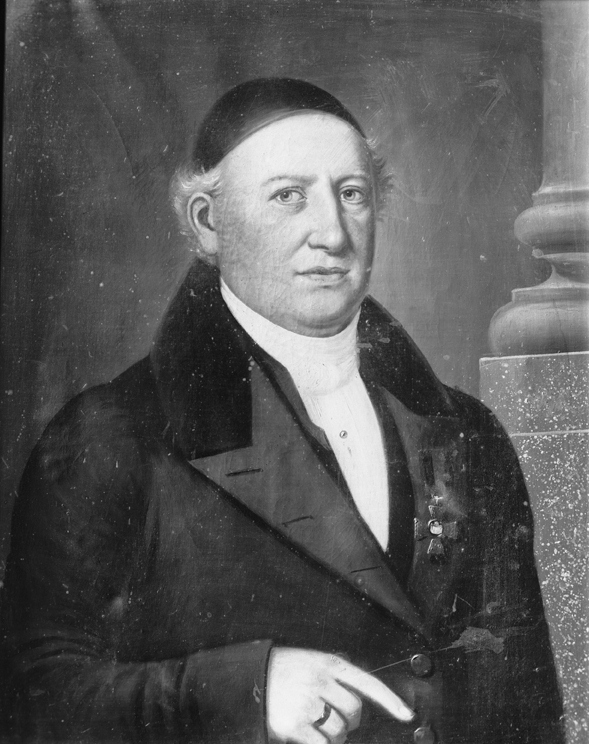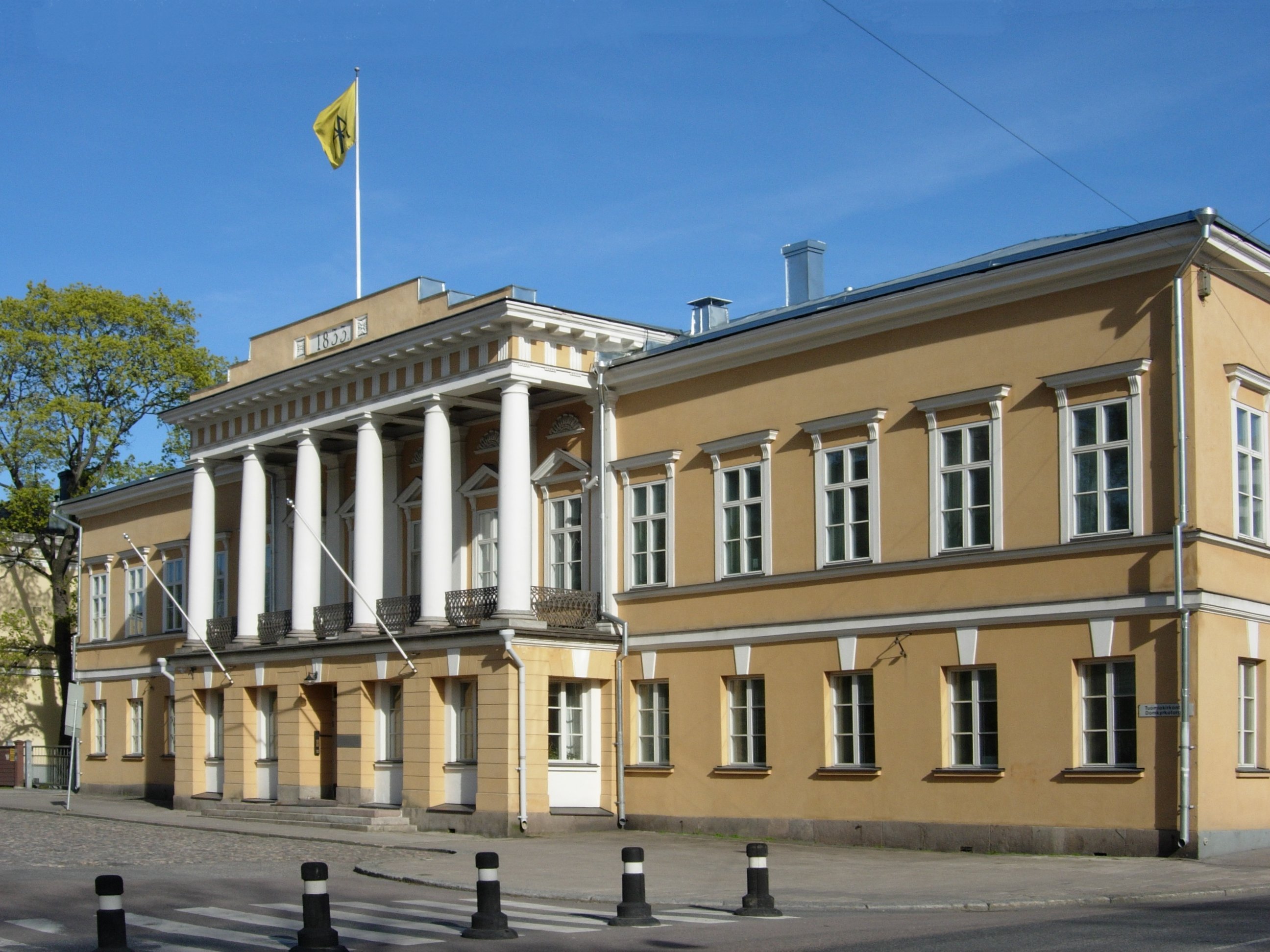|
Carlo Bassi (architect)
Charles (Carlo) Francesco Bassi (12 November 1772, Turin – 11 November 1840, Turku) was a Finnish architect of Italian descent. He was the first professionally trained architect who permanently worked in present-day Finland. He worked, both as an independent architect and as an official responsible for planning new churches, in a Neoclassical style. Life Charles Bassi was the brother of ballet dancer Giovanna Bassi and came with her from present-day Italy to Sweden in 1783. Initially, he was employed by the Swedish King Gustav III as a page but started studying architecture at the Royal Swedish Academy of Arts in Stockholm in 1784. His principal teacher was Louis Jean Desprez. He was awarded prizes at the academy in 1788 and 1790, and after finishing his studies left for an eight-year-long study trip to Italy and Paris. He thereafter returned to Stockholm and began his career as an assistant to Carl Christoffer Gjörwell in his position as city architect of Stockholm. Gjörwell ... [...More Info...] [...Related Items...] OR: [Wikipedia] [Google] [Baidu] |
Charles Bassi Adjusted
Charles is a masculine given name predominantly found in English language, English and French language, French speaking countries. It is from the French form ''Charles'' of the Proto-Germanic, Proto-Germanic name (in runic alphabet) or ''*karilaz'' (in Latin alphabet), whose meaning was "free man". The Old English descendant of this word was ''Churl, Ċearl'' or ''Ċeorl'', as the name of King Cearl of Mercia, that disappeared after the Norman conquest of England. The name was notably borne by Charlemagne (Charles the Great), and was at the time Latinisation of names, Latinized as ''Karolus'' (as in ''Vita Karoli Magni''), later also as ''Carolus (other), Carolus''. Some Germanic languages, for example Dutch language, Dutch and German language, German, have retained the word in two separate senses. In the particular case of Dutch, ''Karel'' refers to the given name, whereas the noun ''kerel'' means "a bloke, fellow, man". Etymology The name's etymology is a Common ... [...More Info...] [...Related Items...] OR: [Wikipedia] [Google] [Baidu] |
Helsinki
Helsinki ( or ; ; sv, Helsingfors, ) is the Capital city, capital, primate city, primate, and List of cities and towns in Finland, most populous city of Finland. Located on the shore of the Gulf of Finland, it is the seat of the region of Uusimaa in southern Finland, and has a population of . The Helsinki urban area, city's urban area has a population of , making it by far the List of urban areas in Finland by population, most populous urban area in Finland as well as the country's most important center for politics, education, finance, culture, and research; while Tampere in the Pirkanmaa region, located to the north from Helsinki, is the second largest urban area in Finland. Helsinki is located north of Tallinn, Estonia, east of Stockholm, Sweden, and west of Saint Petersburg, Russia. It has History of Helsinki, close historical ties with these three cities. Together with the cities of Espoo, Vantaa, and Kauniainen (and surrounding commuter towns, including the eastern ... [...More Info...] [...Related Items...] OR: [Wikipedia] [Google] [Baidu] |
Charles Johnsson
Charles is a masculine given name predominantly found in English and French speaking countries. It is from the French form ''Charles'' of the Proto-Germanic name (in runic alphabet) or ''*karilaz'' (in Latin alphabet), whose meaning was "free man". The Old English descendant of this word was '' Ċearl'' or ''Ċeorl'', as the name of King Cearl of Mercia, that disappeared after the Norman conquest of England. The name was notably borne by Charlemagne (Charles the Great), and was at the time Latinized as ''Karolus'' (as in ''Vita Karoli Magni''), later also as '' Carolus''. Some Germanic languages, for example Dutch and German, have retained the word in two separate senses. In the particular case of Dutch, ''Karel'' refers to the given name, whereas the noun ''kerel'' means "a bloke, fellow, man". Etymology The name's etymology is a Common Germanic noun ''*karilaz'' meaning "free man", which survives in English as churl (< Old English ''ċeorl''), which developed its depre ... [...More Info...] [...Related Items...] OR: [Wikipedia] [Google] [Baidu] |
Pehr Johan Gylich
Pehr is a predominantly Swedish language masculine give name and may refer to: *Pehr Adlerfelt (1680–1743), Swedish Army colonel *Pehr von Afzelius (1760–1843), Swedish medical doctor and professor *Pehr Victor Edman (1916—1977), Swedish biochemist *Pehr von Ehrenheim (1823–1918), Swedish politician *Peter Forsskål, Pehr Forsskål (also known as Peter Forsskål; 1732–1763), Swedish-Finnish explorer, orientalist and naturalist *Pehr Götrek (1798–1876), Swedish Christian communist *Pehr Gyllenhammar (1901–1988), Swedish businessman *Pehr G. Gyllenhammar (born 1935), Swedish businessman *Pehr Harbury (born 1965), American biochemist *Pehr Hilleström (1732–1816), Swedish artist *Pehr Ferdinand Holm (1844–1917), Swedish-born New Zealand mariner *Pehr G. Holmes (1881–1952), Swedish-born American politician *Pehr Hörberg (1746–1816), Swedish painter and musician *Pehr Janse (1893–1961), Swedish Army major general *Pehr Kalm (1716–1779), Finnish explorer a ... [...More Info...] [...Related Items...] OR: [Wikipedia] [Google] [Baidu] |
Colonnade
In classical architecture, a colonnade is a long sequence of columns joined by their entablature, often free-standing, or part of a building. Paired or multiple pairs of columns are normally employed in a colonnade which can be straight or curved. The space enclosed may be covered or open. In St. Peter's Square in Rome, Bernini's great colonnade encloses a vast open elliptical space. When in front of a building, screening the door (Latin ''porta''), it is called a portico. When enclosing an open court, a peristyle. A portico may be more than one rank of columns deep, as at the Pantheon in Rome or the stoae of Ancient Greece. When the intercolumniation is alternately wide and narrow, a colonnade may be termed "araeosystyle" (Gr. αραιος, "widely spaced", and συστυλος, "with columns set close together"), as in the case of the western porch of St Paul's Cathedral and the east front of the Louvre. History Colonnades have been built since ancient times and inter ... [...More Info...] [...Related Items...] OR: [Wikipedia] [Google] [Baidu] |
Åbo Akademi University
Åbo Akademi University ( sv, Åbo Akademi , ) is the only exclusively Swedish language multi-faculty university in Finland (or anywhere outside Sweden). It is located mainly in Turku (Åbo is the Swedish name of the city) but has also activities in Vaasa. Åbo Akademi should not be confused with the Royal Academy of Åbo, which was founded in 1640, but moved to Helsinki after the Turku fire of 1827 and is today known as the University of Helsinki. Åbo Akademi was founded by private donations in 1918 as the third university in Finland, both to let Turku again become a university town and because it was felt that the Swedish language was threatened at the University of Helsinki. The Finnish University of Turku was founded in 1920, also by private donations and for similar reasons. Åbo Akademi was a private institution until 1981, when it was turned into a public institution. As the only uni-lingually Swedish multi-faculty university in the world outside Sweden and consequent ... [...More Info...] [...Related Items...] OR: [Wikipedia] [Google] [Baidu] |
Gothic Revival Architecture
Gothic Revival (also referred to as Victorian Gothic, neo-Gothic, or Gothick) is an architectural movement that began in the late 1740s in England. The movement gained momentum and expanded in the first half of the 19th century, as increasingly serious and learned admirers of the neo-Gothic styles sought to revive medieval Gothic architecture, intending to complement or even supersede the neoclassical styles prevalent at the time. Gothic Revival draws upon features of medieval examples, including decorative patterns, finials, lancet windows, and hood moulds. By the middle of the 19th century, Gothic had become the preeminent architectural style in the Western world, only to fall out of fashion in the 1880s and early 1890s. The Gothic Revival movement's roots are intertwined with philosophical movements associated with Catholicism and a re-awakening of high church or Anglo-Catholic belief concerned by the growth of religious nonconformism. Ultimately, the "Anglo-Catholicism" t ... [...More Info...] [...Related Items...] OR: [Wikipedia] [Google] [Baidu] |
Joensuu Manor
Joensuu (; krl, Jovensuu; ) is a city and municipality in North Karelia, Finland, located on the northern shore of Lake Pyhäselkä (northern part of Lake Saimaa) at the mouth of the Pielinen River (''Pielisjoki''). It was founded in 1848. The population of Joensuu is (), and the economic region of Joensuu has a population of 115,000. It is the largest city in Finland. The nearest major city, Kuopio in North Savonia, is located to the west. From Joensuu, the distance to Lappeenranta, the capital of South Karelia, is along Highway 6. As is typical of cities in Eastern Finland, Joensuu is monolingually Finnish. Along with Kuopio, Joensuu is one of major urban, economic, and cultural hubs of Eastern Finland. Joensuu is a student city with a subsidiary of the University of Eastern Finland, which has over 20,000 enrolled students, and a further 4,000 students at the Karelia University of Applied Sciences. Heraldry The explanation of the coat of arms of Joensuu reads: ”shield ... [...More Info...] [...Related Items...] OR: [Wikipedia] [Google] [Baidu] |
Saint Petersburg
Saint Petersburg ( rus, links=no, Санкт-Петербург, a=Ru-Sankt Peterburg Leningrad Petrograd Piter.ogg, r=Sankt-Peterburg, p=ˈsankt pʲɪtʲɪrˈburk), formerly known as Petrograd (1914–1924) and later Leningrad (1924–1991), is the second-largest city in Russia. It is situated on the Neva River, at the head of the Gulf of Finland on the Baltic Sea, with a population of roughly 5.4 million residents. Saint Petersburg is the fourth-most populous city in Europe after Istanbul, Moscow and London, the most populous city on the Baltic Sea, and the world's northernmost city of more than 1 million residents. As Russia's Imperial capital, and a historically strategic port, it is governed as a federal city. The city was founded by Tsar Peter the Great on 27 May 1703 on the site of a captured Swedish fortress, and was named after apostle Saint Peter. In Russia, Saint Petersburg is historically and culturally associated with t ... [...More Info...] [...Related Items...] OR: [Wikipedia] [Google] [Baidu] |
Uppland
Uppland () is a historical province or ' on the eastern coast of Sweden, just north of Stockholm, the capital. It borders Södermanland, Västmanland and Gästrikland. It is also bounded by lake Mälaren and the Baltic Sea. On the small uninhabited island of Märket in the Baltic, Uppland has a very short and unusually shaped land border with Åland, an autonomous province of Finland. The name literally means ''up land'', a name which is commonly encountered in especially older English literature as ''Upland''. Its Latinised form, which is occasionally used, is ''Uplandia''. Uppland is famous for having the highest concentration of runestones in the world, with as many as 1,196 inscriptions in stone left by the Vikings. Administration The traditional provinces of Sweden serve no administrative or political purposes, but are historical and cultural entities. The corresponding administrative county, or ', is Uppsala County, which occupies the larger part of the territory. The b ... [...More Info...] [...Related Items...] OR: [Wikipedia] [Google] [Baidu] |
Aske Manor
Aske Manor (''Aske herrgård'') is a manor house located in Upplands-Bro Municipality, Stockholm County, Sweden. History The history of the estate goes back to at least the 14th century, when it is mentioned in written sources for the first time. During the 17th century it belonged to the De la Gardie family, including Privy Councilor Jacob De la Gardie (1583–1652). During the 18th century it belonged to families Olivecrantz, Wallrawe, Drufva, Leijonstedt, Ingelotz and Fleetwood. In 1799 it was sold to C. G. Sehmann, who built the present main building in Neoclassical architectural style to designs by Italian born, Finnish architect Charles Bassi Charles (Carlo) Francesco Bassi (12 November 1772, Turin – 11 November 1840, Turku) was a Finnish architect of Italian descent. He was the first professionally trained architect who permanently worked in present-day Finland. He worked, both as an ... (1772-1840). Today it houses a conference venue, Villa Aske. References Exter ... [...More Info...] [...Related Items...] OR: [Wikipedia] [Google] [Baidu] |




